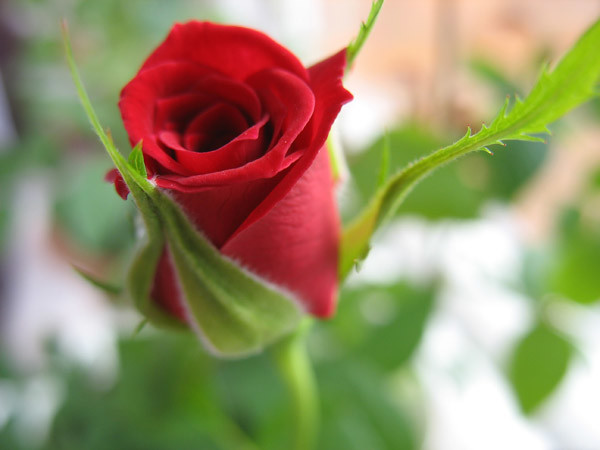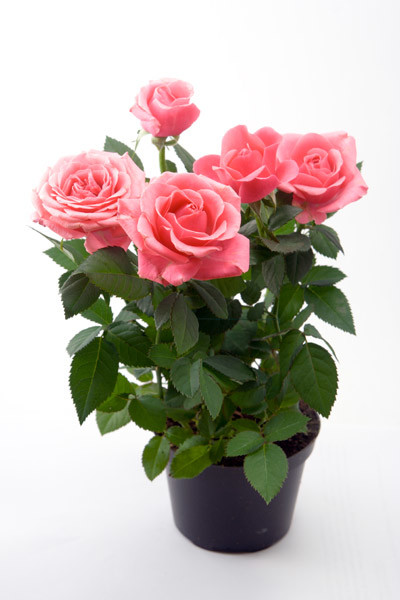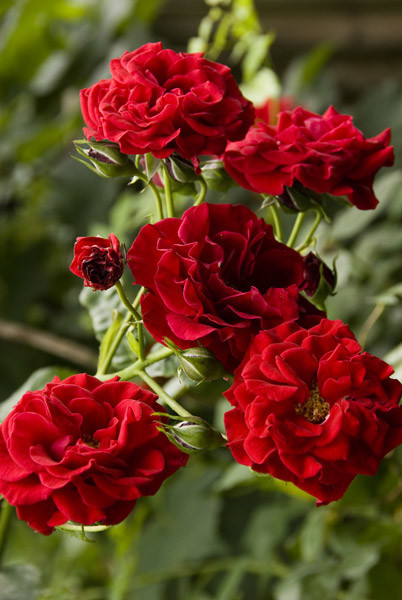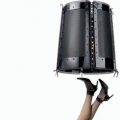Rule number 1. No - overheating!
 Room rose care House roses grow wellat a temperature of from 10 to 25 ° С, its daily fluctuations and small frosts easily tolerate. Just do not tolerate overheating. They should be placed in a well-lit window and at the same time ensure that there is not too hot. This requires regular airing and shading of the pot from the hot sun rays. The soil in the pot should not be heated. The best option is a western or eastern window. On the southern windowsill, additional difficulties arise: frequent watering due to the rapid drying out of the soil, mandatory ventilation. And even if these conditions are met, the rose will suffer from overheating here in the summer, drop buds and leaves, and give a weak increase. Opened flowers will last just a couple of days. Therefore, the south window is suitable only at other times of the year. On the north window, you can water less often, not be afraid of overheating, but here you can’t do without additional lighting.
Room rose care House roses grow wellat a temperature of from 10 to 25 ° С, its daily fluctuations and small frosts easily tolerate. Just do not tolerate overheating. They should be placed in a well-lit window and at the same time ensure that there is not too hot. This requires regular airing and shading of the pot from the hot sun rays. The soil in the pot should not be heated. The best option is a western or eastern window. On the southern windowsill, additional difficulties arise: frequent watering due to the rapid drying out of the soil, mandatory ventilation. And even if these conditions are met, the rose will suffer from overheating here in the summer, drop buds and leaves, and give a weak increase. Opened flowers will last just a couple of days. Therefore, the south window is suitable only at other times of the year. On the north window, you can water less often, not be afraid of overheating, but here you can’t do without additional lighting.
Rule number 2. Abundant watering
The second important condition is regular, abundantwatering and frequent fertilizing. Drying out of the soil is simply unacceptable: this can lead to the death of the plant. During active growth and especially flowering, watering should be abundant, but without stagnation of water in the tray. About half an hour after watering, unabsorbed water from the tray must be drained. Roses in small pots should be watered more often, because the soil in them dries out faster. In sunny weather, watering is daily, in cloudy weather - a little less often, about once every two days, but everything depends on the specific conditions.
Rule number 3. Regular feeding
Roses are very demanding when it comes to fertilizing.This is due to almost continuous flowering, which takes a lot of energy. Therefore, from early spring to autumn, roses are fed once a week with organic or mineral fertilizers, you can alternately. It is very convenient to use liquid flower fertilizers for this purpose, of which there are many on sale. In spring, foliar feeding will also have a beneficial effect, 3-4 with an interval of 10-12 days is enough. Another important point is air humidity. Many sources indicate that indoor roses need high air humidity. But from personal experience, I am convinced that roses grow quite well without spraying. A couple of times a month they can be given a shower to wash off the dust, and that's it. But high air humidity and frequent spraying can contribute to the development of fungal diseases.
Care calendar
Now let's look at caring for indoor rosesthroughout the year. Let's start with the awakening of the buds and the appearance of young shoots in early spring. They signal the end of dormancy and the beginning of active vegetation. This means that the time has come for feeding, pruning and placing on a sunny window (if the wintering took place in a separate cool room). The plant should be carefully fed with a solution of mineral fertilizers, after pouring clean water over the soil. If the rose has just been planted in fresh soil, then feeding is not yet necessary. With the appearance of young foliage, foliar feeding can be carried out. Branches, which stimulates the rapid growth of young shoots, on which such desired flowers will form. Further care consists of observing the rules above. With the onset of sustainable warm indoor rosespreferably for the whole summer to send to the open air - on the balcony or loggia, in the garden. This has a very positive effect on the general condition of roses and contributes to long and abundant blooms until autumn. If this is not possible, then you need to place them on the east or west window, where it is not so hot. Fading roses must be cut to the first leaf in a timely manner so as not to weaken the plant by setting fruit. Moreover, it is better to cut off before the flowers bloom completely, before the appearance of stamens, and begin to throw off the petals themselves. All fallen and yellowed leaves, drying sprigs must be removed immediately in order to avoid the appearance of diseases. The flowering shoots are also periodically cut to stimulate further growth. At the end of the summer, care should be taken that fertilizers do not contain nitrogen as the plant prepares for a dormant period. This period lasts from about mid-autumn to February. If the roses were summer in the fresh air, then around the end of August and the beginning of September they are brought into the room. At this time, fertilization is completely stopped, watering is gradually reduced and the plants are placed in a cool place with a temperature of up to +10 ° C. In such conditions, the leaves begin to turn yellow and fall off, the plant enters a state of rest. After that, the pot with a rose should be placed in a cool place with a temperature of + 3 ... 6 ° С. In urban conditions, a glazed and insulated loggia is quite suitable, where in winter the air temperature does not fall below + 2 ... 4 ° С. After the leaves subside, watering is almost completely stopped, only occasionally slightly moistened with an earthy lump, because the complete drying out of the soil can be destructive. The stalks are shortened, leaving hemp up to 10 cm high with several buds. In February, roses from a cool room are transferred to a warm one (+ 10 ... 12 ° C) for gradual awakening. It is advisable to first transplant them into fresh fertile soil. With the advent of young leaves, plants are placed on a well-lit window-sill in a warm room. Now they need to be plentifully watered, fertilized, ventilated. And with the advent of sustainable heat - again in the fresh air.
With the onset of sustainable warm indoor rosespreferably for the whole summer to send to the open air - on the balcony or loggia, in the garden. This has a very positive effect on the general condition of roses and contributes to long and abundant blooms until autumn. If this is not possible, then you need to place them on the east or west window, where it is not so hot. Fading roses must be cut to the first leaf in a timely manner so as not to weaken the plant by setting fruit. Moreover, it is better to cut off before the flowers bloom completely, before the appearance of stamens, and begin to throw off the petals themselves. All fallen and yellowed leaves, drying sprigs must be removed immediately in order to avoid the appearance of diseases. The flowering shoots are also periodically cut to stimulate further growth. At the end of the summer, care should be taken that fertilizers do not contain nitrogen as the plant prepares for a dormant period. This period lasts from about mid-autumn to February. If the roses were summer in the fresh air, then around the end of August and the beginning of September they are brought into the room. At this time, fertilization is completely stopped, watering is gradually reduced and the plants are placed in a cool place with a temperature of up to +10 ° C. In such conditions, the leaves begin to turn yellow and fall off, the plant enters a state of rest. After that, the pot with a rose should be placed in a cool place with a temperature of + 3 ... 6 ° С. In urban conditions, a glazed and insulated loggia is quite suitable, where in winter the air temperature does not fall below + 2 ... 4 ° С. After the leaves subside, watering is almost completely stopped, only occasionally slightly moistened with an earthy lump, because the complete drying out of the soil can be destructive. The stalks are shortened, leaving hemp up to 10 cm high with several buds. In February, roses from a cool room are transferred to a warm one (+ 10 ... 12 ° C) for gradual awakening. It is advisable to first transplant them into fresh fertile soil. With the advent of young leaves, plants are placed on a well-lit window-sill in a warm room. Now they need to be plentifully watered, fertilized, ventilated. And with the advent of sustainable heat - again in the fresh air. If it is not possible to provide a coolwintering means that you have to provide additional lighting and the coolest window sill (preferably not higher than 15 ° C). With this variant of wintering, it is necessary to especially carefully monitor the condition of the roses, often spray them, protect them from the hot air from the heating devices. It is in the dry warm winter conditions that the spider mite is most likely to appear. Feeding is carried out about once every 2-3 weeks with a weakly concentrated fertilizer solution. But if winter is successfully experienced, then in March the first buds will appear on the roses. As soon as the buds start to grow at the end of winter, it is necessary to prune the roses. Four to six well-matured branches are left on the plant, shortening them to 5–8 cm, so that there are 3-5 buds on each. In this case, the upper bud should not be directed inside the future bush, but outwards. After that, the plant is transplanted into fresh soil and left until young shoots appear. When pruning roses, it should be remembered that it is enough to shorten miniature species by one third. But tall indoor roses pruned more cardinally, leaving several buds, as described above.
If it is not possible to provide a coolwintering means that you have to provide additional lighting and the coolest window sill (preferably not higher than 15 ° C). With this variant of wintering, it is necessary to especially carefully monitor the condition of the roses, often spray them, protect them from the hot air from the heating devices. It is in the dry warm winter conditions that the spider mite is most likely to appear. Feeding is carried out about once every 2-3 weeks with a weakly concentrated fertilizer solution. But if winter is successfully experienced, then in March the first buds will appear on the roses. As soon as the buds start to grow at the end of winter, it is necessary to prune the roses. Four to six well-matured branches are left on the plant, shortening them to 5–8 cm, so that there are 3-5 buds on each. In this case, the upper bud should not be directed inside the future bush, but outwards. After that, the plant is transplanted into fresh soil and left until young shoots appear. When pruning roses, it should be remembered that it is enough to shorten miniature species by one third. But tall indoor roses pruned more cardinally, leaving several buds, as described above.
Reproduction
To plant indoor roses you needFertile soil rich in nutrients. An approximate mixture is made up of humus, peat and sand in a ratio of 2:2:1. Good drainage is required at the bottom of the pot. It is useful to add pieces of charcoal and some potassium-rich wood ash to the soil. Indoor roses are quite easy to propagate by cuttings. To do this, cuttings are taken from mature branches from May to September. It is best to cut the cutting from the middle of a thin, faded branch, leaving 2-4 buds on it. In this case, the lower cut is made obliquely 1 cm below the bud (the bud should be directed upwards), and the upper cut is straight, 0.5 cm above the upper bud. Cuttings are rooted in water or in a mixture of peat (or light soil) with sand. Freshly cut cuttings are immediately placed in water or sand, because even short-term drying reduces rooting. Rooting in water has one interesting feature: the water poured for the first time cannot be changed, you can only add as it decreases in the jar. Even if it turns green, do not pour it out under any circumstances! Oddly enough, cuttings root perfectly this way! After the roots grow 1-2 cm long, the cuttings must be planted in the soil. The root collar is not deepened, it remains at the soil level. The roots are very fragile, so they are placed very carefully and sprinkled with soil. After watering and lightly pressing the soil, the pot with the cutting is placed in a light place protected from direct sunlight. After a couple of weeks, the buds begin to grow. When rooting cuttings in sand, they are buried 1 cm deep so that the bud sticks out slightly on the surface, watered, pressed around the sand and covered with glass or film. Placed in a warm, light place where the temperature does not fall below 18 ° C. Otherwise, the rooting percentage drops sharply. Self-propagation of indoor roses by cuttings allows you to get plants adapted specifically to the conditions of a given room, which simplifies their further cultivation. After all, a rose is essentially an outdoor plant, and for seedlings of your own "making" the problem of adaptation no longer exists.
Diseases and pests
Unfortunately, pests and diseases do not bypassside of indoor roses. Aphids often settle on the delicate tops. If there are few of them, you can simply collect the insects by hand. Otherwise, it is better to use special preparations, of which there are many on sale, for example, Intavir. "Grandma's" methods such as soap solution or garlic, in my opinion, are not effective enough, in any case, I have long abandoned this, without getting the desired result. It is very difficult to prevent the appearance of spider mites, especially in the autumn-winter period. He simply adores indoor roses no less than an amateur gardener and is capable of destroying a plant in a matter of days! And here, certainly, nothing will help, except for special preparations such as Fitoverm, Actellic, etc. But since it is always easier to prevent a disease than to treat it, I can recommend that you carry out preventive spraying of all houseplants twice a year, for example, with Fitoverm or something similar. Stagnant humid air around roses and dampness lead to the occurrence of fungal diseases: powdery mildew, gray rot, rust and others. Special fungicides such as Topaz or Fundazol are used against this. Therefore, it is better to avoid dense plantings, promptly cut off faded shoots, water roses without wetting the leaves, loosen the soil after watering, regularly ventilate the room. It should be remembered that the treatment of roses with any preparations is carried out outside living quarters, always in a place protected from sunlight. After treatment, roses are left there for about a day and only then brought back into the room.









